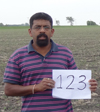NEWS | June 17, 2012
Crop Structure Sampling

During the SMAPVEX12 campaign measurements are being made simultaneously by airborne remote sensing instruments (PALS and UAVSAR) and by in situ sampling of the field sites. Measurements of the vegetation/crop structure characteristics and attributes during the vegetation growth phases are an important part of the data collection.
Crop structure measurements collected during the campaign will be used to calibrate and validate (cal/val) the SMAP radar forward models (radar backscatter is highly sensitive to vegetation structure). For this purpose most of the landcover types available in the SMAPVEX12 study domain are being sampled to obtain vegetation/crop structure information.
Seventeen fields were strategically selected for vegetation structure sampling from the total of 54 fields that are being sampled. They are: 1 forage, 1 winter-wheat, 3 corn, 3 bean, 3 pasture, 3 spring-wheat, and 3 canola fields.
Vegetation/crop attributes that are measured include plant height, stem width, stalk height, stalk angle, number of leaves, leaf length, leaf width, leaf thickness, leaf angle, number of plants per square meter, row orientation and row width. These are the attributes known to influence the radar backscatter from a vegetated surface.
These vegetation attributes are being measured in all 17 fields. The sampling strategy is to measure the attributes at a regular interval to capture the change/growth/decay of vegetation during the SMAPVEX12 field campaign.
Figs 1 and 2 show the structural change/growth of canola plants (field 124) within a span of 9 days. Similar substantial growth is observed at other crop fields, e.g., corn (Figs 3 and 4).




